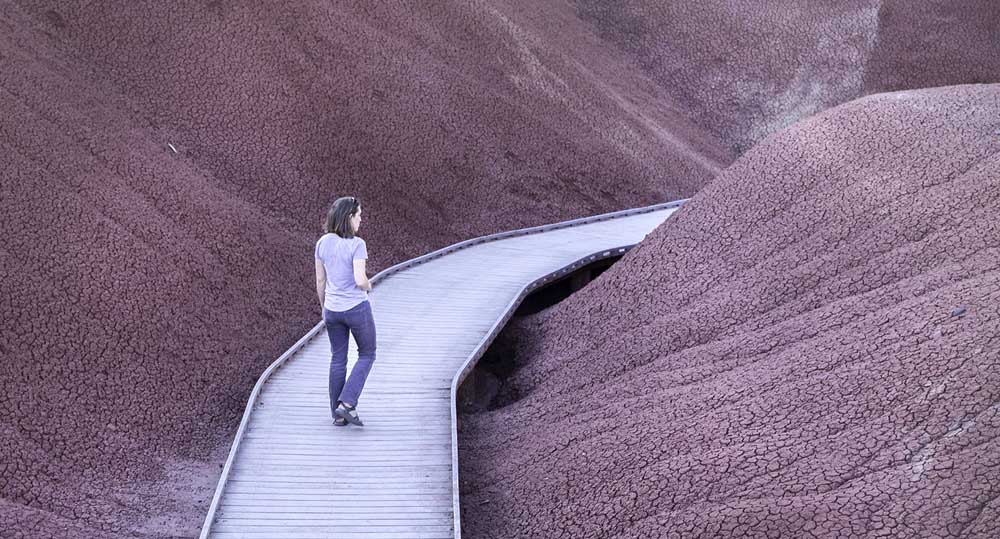Painted Hills live up to billing
Published 8:30 am Monday, August 29, 2016

- Lindsay Chiono strolls a short boardwalk that is part of the Painted Cove Trail in the Painted Hills Unit near Mitchell.
The Painted Hills have beckoned to me for years.
I just never seemed to get to that part of Central Oregon. When my husband, Bill, started planning a fishing trip on the John Day River, however, I realized the national monument was just down the road. We arrived at our campsite last Saturday and pitched our tents, and then Bill and our son-in-law, Anton, set out to the river where they would launch our drift boat and happily hook smallmouth bass for much of the afternoon.
My daughter Lindsay and I set out for a half-hour drive to the Painted Hills, 9 miles north of Mitchell. On the way, I asked Lindsay to describe the hills since she’d seen them on another trip. They are beautiful and colorful, she said, and almost cartoonish in their exaggerated hues, lumps and swirls.
“Cartoonish,” I mused.
I rolled the word around in my brain, but it wasn’t until I saw my first painted hill that her description actually made sense. The otherworldly landscape seemed as if Mother Nature had dialed up the vibrancy and saturation of the yellow, red and golden layers of stratified clay. Mounds and moguls filled the scene, some appearing as whipping cream just as it gets thick and the beaters make ripples and folds.
I could imagine a Dr. Seuss character such as the Lorax, Sam-I-Am or Horton the Elephant sauntering into the scene. Cartoonish and stunningly beautiful.
We learned that the bands of color represent changes in climate in the last 32-35 million years. The red strata came from more tropical times, and the yellows indicate a drier and cooler climate. Black streaks and stains indicated manganese, likely left by plants. The colors intensify during rainstorms.
We pulled out our cameras and stayed absorbed in photographing the scene as we slowly walked the half mile Painted Hills Overlook Trail out and back. We passed knots of other gawkers who seemed mesmerized by the view. Judging by the accents, many were foreign. A large group from India was visiting this day.
The superintendent of the John Day Fossil Beds National Monument (which contains the Painted Hills and is administered by the National Park Service) said tourist numbers jumped at the Painted Hills after Travel Oregon in 2013 named the site as one of the Seven Wonders of Oregon.
“Visitation has gone up significantly since then,” said Superintendent Shelley Hall.
She said the number of visitors rose from 45,849 people to 74,873 in 2015. Hall attributed some of the spike to mild winters and the low price of gas, but suspects that the Travel Oregon designation spurred much of the gain. She has noticed a definite increase in both domestic and foreign visitors.
The superintendent said increased visitor traffic has created challenges at the national monument. Her staff worries more about the fragile environment, but acknowledged that people are generally pretty respectful. It’s really the little things that cause extra angst, she said. The toilet paper in the visitor center bathroom, for example, now must be resupplied multiple times each day, whereas before once every day or two was enough. Visitors can remain happily oblivious to the logistics and the extra expense, though — they get to gaze at the magnificent scene free of charge. They must merely heed signs that instruct hikers to stick to the trail and not put pressure on the delicate ecosystem.
Lindsay and I hiked up the 1.6-mile Carroll Rim Trail, navigating a series of switchbacks to a high place where we got a panoramic view of the Painted Hills, Sutton Mountain and a large swath of the area. We weren’t alone, but I didn’t really care. I felt strangely bonded with all these other visitors in our appreciation of this jewel of Oregon.
Our last micro hike was the Painted Cove Trail, a quarter-mile loop that allows walkers to get close enough to eyeball the pockmarked surface of the colorful rock. Two other short hikes include the Leaf Hill Trail, the site of paleontological research, and the Red Scar Knoll Trail, an out-and-back trek to a multi-colored knoll.
As we drove back to our camp site to sip wine and listen to stories of bass, I marinated in our recent adventure. Yes, I thought, the Painted Hills had lived up to their billing.





